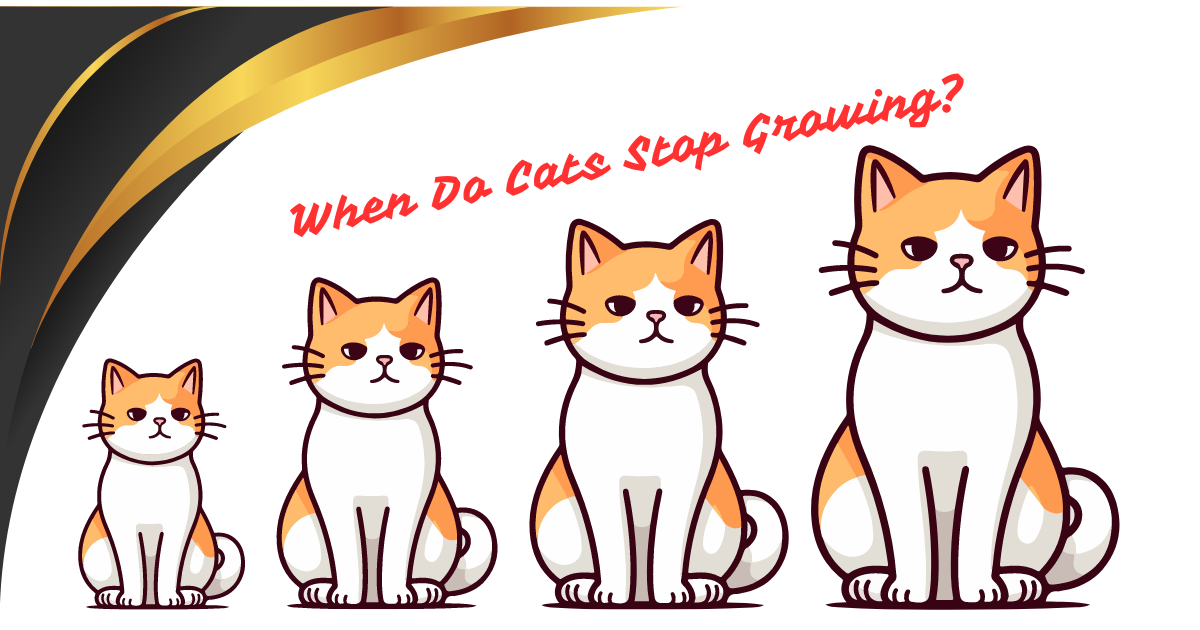Watching your kitten grow into a healthy adult cat is an exciting process, but many pet owners wonder, “When do cats stop growing?” While most cats experience rapid growth in their first year, their growth doesn’t always stop completely after that. Understanding the different stages of your cat’s development and what factors influence their size can help you ensure they are on track to reach their full potential.
In this guide, we’ll explore the fascinating growth journey of cats, from kittenhood to adulthood, and provide insights into the different factors that affect their size. We’ll also answer common questions like “Do cats grow after 1 year?” and how to tell when your cat is fully grown. Whether you’re a new cat owner or simply curious about your feline friend’s development, this article will give you everything you need to know about cat growth stages.
1. When Do Cats Stop Growing? The Timeline Explained
Most cats reach their full size by the time they are 12 to 18 months old, but this timeline can vary depending on several factors, such as breed and health. Kittens go through an intense growth phase during their first year, especially during the first six months, when they develop rapidly in size, strength, and coordination.
During the first few weeks of life, kittens rely entirely on their mother’s milk for nutrition, and their growth is mostly internal, focusing on their organs and skeletal structure. By 8 weeks, most kittens are ready for solid food and continue growing at a fast pace.
From 3 to 6 months, you’ll notice significant physical changes in your kitten. They will grow longer, their bones and muscles will strengthen, and their energy levels will soar. This period is crucial for their development, and proper nutrition is vital to support their growing bodies.
Once a kitten reaches 6 months, their growth rate slows down, but they continue to fill out and mature. By the time they are 1 year old, many cats have reached their adult size, although some may continue to grow slightly for a few more months.
In larger cat breeds like Maine Coons, growth can continue for up to 2-3 years. Therefore, while most cats stop growing at around 12 to 18 months, the final timeline depends on factors like breed, diet, and overall health.
2. Do Cats Grow After 1 Year? Understanding Growth Stages
A common question among cat owners is, “Do cats grow after 1 year?” The answer is that while many cats have reached near-adult size by their first birthday, they may still experience slight growth after this milestone. However, the rate of growth is much slower compared to their first year of life.
The growth stages of a cat can be broken down into several key phases:
- Kittenhood (0-6 months): During this period, kittens experience rapid growth, increasing in size and weight significantly. They are developing their bones, muscles, and coordination.
- Adolescence (6-12 months): Between 6 and 12 months, kittens enter adolescence. Their growth rate slows, but they continue to mature and build muscle. This stage is crucial for socialization and behavioral development.
- Young Adulthood (1-2 years): At this point, most cats have reached their full height and length, but they may continue to “fill out” as their muscles and body structure fully develop. Larger breeds may still experience slight growth during this stage.
- Adulthood (2+ years): By the age of 2 years, most cats are fully grown and have reached their peak physical condition.
Though cats may continue to mature emotionally and socially after their first year, their physical growth slows significantly. After 1 year, cats generally focus on maintaining their weight and muscle mass rather than growing taller or longer.
Understanding these growth stages can help you provide the right care and nutrition at each phase to ensure your cat grows into a healthy adult.
3. Factors That Affect Cat Growth: What You Should Know
Several factors influence how big cats get and when they stop growing. Understanding these factors can help you better manage your cat’s development and ensure they grow healthily.
Here are the main factors that impact cat growth:
- Breed: Breed plays a significant role in a cat’s growth. Smaller breeds, like the Siamese, often reach full size by 12 months, while larger breeds, such as the Maine Coon, can continue growing for up to 3 years. Mixed-breed cats typically follow an average growth timeline, but their genetics can still influence how long they grow.
- Nutrition: Proper nutrition is essential for healthy growth. A diet rich in proteins, vitamins, and minerals will ensure your cat’s bones, muscles, and organs develop properly. Kittens fed a poor diet or insufficient calories may have stunted growth or fail to reach their full potential. Make sure your cat is eating high-quality, well-balanced food during its growing stages.
- Health: Health conditions, such as parasites, infections, or chronic illnesses, can hinder a cat’s growth. Regular vet check-ups and vaccinations are important to detect and prevent illnesses that could impact development.
- Genetics: Genetics also plays a significant role in determining how big your cat will get and when it will stop growing. Cats with smaller parents may grow at a faster pace and reach their adult size earlier, while those from larger families may experience prolonged growth.
- Spaying/Neutering: There’s a debate about whether early spaying or neutering affects a cat’s growth. Some studies suggest that cats neutered early might grow slightly larger because the lack of hormones allows their bones to grow for a longer period.
By ensuring proper diet and veterinary care, you can support your cat’s growth and help them reach their full size in a healthy way.
4. Cat Size by Breed: How Different Breeds Have Unique Growth Patterns
Just like humans, different cat breeds have unique growth patterns that determine their size and when they stop growing. The growth rate and final size can vary significantly depending on the breed of the cat.
Here are a few examples of how cat size by breed can differ:
- Maine Coon: Known as one of the largest domestic cat breeds, the Maine Coon can take up to 3 years to fully grow. These gentle giants can weigh anywhere between 12 to 18 pounds (and sometimes more), with long bodies and thick, muscular frames.
- Siamese: On the smaller side, Siamese cats generally reach their adult size by the time they are 12 months old. They typically weigh between 6 to 12 pounds, with a slender, lean build.
- Persian: Persians are a medium-sized breed with a fluffy coat and round face. They usually reach their adult size by 18 months, weighing between 7 to 12 pounds.
- Ragdoll: Another large breed, Ragdolls can take up to 2-3 years to fully grow. They are known for their big size, with males weighing up to 20 pounds or more.
- Bengal: Bengals are athletic and muscular cats, typically reaching their full size by 18 months. They usually weigh around 8 to 15 pounds, depending on their genetics.
As you can see, the breed of the cat plays a crucial role in determining when they will stop growing and how large they will become. Understanding your cat’s breed can help set expectations for their growth timeline and final size.
5. When Do Kittens Stop Growing? A Guide for New Cat Owners
For new cat owners, one of the most common questions is, “When do kittens stop growing?” Kittens undergo rapid development during the first few months of their lives, and knowing when they will reach full size can help you plan their care and nutrition.
Here’s a general breakdown of kitten growth stages:
- Birth to 8 weeks: During the first two months of life, kittens rely on their mother’s milk for nourishment. They grow rapidly during this time, and by 8 weeks, they usually weigh around 2 pounds and are ready to start eating solid food.
- 8 weeks to 6 months: This is the most intense growth period for kittens. They will gain weight quickly, build muscle, and develop coordination. By 6 months, most kittens have reached 75-80% of their adult size.
- 6 months to 12 months: Between 6 and 12 months, a kitten’s growth rate slows, but they continue to fill out and mature. They will reach near-adult size by 1 year, though some cats may continue to grow slightly.
- 12 to 18 months: Most cats stop growing by 12 to 18 months, with only minor changes in their size after this period. However, larger breeds like the Maine Coon or Ragdoll can take up to 3 years to fully mature.
By 12 to 18 months, kittens are typically considered fully grown, though some larger breeds take longer to reach their full potential. Providing high-quality food and regular veterinary care throughout this time is essential for healthy growth.
Curious about other common cat dangers? Find out why chocolate is a major no-no for cats in our guide: Can Cats Eat Chocolate? 5 Alarming Facts Every Cat Owner Should Know!.
Conclusion
When do cats stop growing? While most cats reach their full size by 12 to 18 months, the exact timeline depends on factors such as breed, diet, and overall health. Larger breeds like Maine Coons may continue growing for up to 2-3 years, while smaller breeds stop growing sooner. Understanding the stages of cat growth and providing the right nutrition and care during these stages is essential for your cat’s development.
In this guide, we’ve covered the key factors that influence growth, how to tell if your cat is fully grown, and what you can do to support their health during these important growth phases. By following these tips, you can ensure that your cat grows into a happy, healthy adult, reaching their full potential in size and strength.
FAQs About When Cats Stop Growing
- When do cats stop growing?
Most cats stop growing between 12 to 18 months, but some larger breeds, like the Maine Coon, can continue growing until they are 2-3 years old. - Do cats grow after 1 year?
While most cats have reached near-adult size by their first birthday, they may continue to grow slightly, especially in terms of muscle mass, until they are 18 months to 2 years old. - How can I tell if my cat is fully grown?
You can tell if your cat is fully grown by their weight, size, and overall development. A fully grown cat will have reached its adult weight and muscle structure, and your vet can confirm if your cat has completed its growth. - Does a cat’s breed affect when it stops growing?
Yes, breed plays a significant role. Smaller breeds, like the Siamese, tend to stop growing by 12 months, while larger breeds like the Ragdoll and Maine Coon may continue growing until they are 2-3 years old. - Do neutering or spaying affect a cat’s growth?
Neutering or spaying can slightly influence growth by delaying the closure of growth plates, leading to slightly longer bones, but it generally does not significantly affect overall size. - What factors influence how big a cat will get?
Factors like breed, genetics, diet, and health play key roles in how big a cat will get. Proper nutrition and regular veterinary care ensure healthy growth. - At what age do kittens reach adult size?
Most kittens reach adult size by 12 to 18 months, though their growth rate slows down significantly after 6 months. Larger breeds may take longer. - How much should a full-grown cat weigh?
A full-grown cat typically weighs between 8 to 12 pounds, though this varies depending on the breed. Larger cats like Maine Coons can weigh up to 18 pounds or more, while smaller breeds like Siamese may weigh less than 8 pounds. - What should I feed my kitten to support healthy growth?
Feed your kitten a high-quality, protein-rich diet specifically designed for kittens to support their rapid growth and development. Consult your vet for the best food recommendations based on your cat’s breed and size. - Can illness affect a cat’s growth?
Yes, health issues like parasites, infections, or chronic conditions can stunt a cat’s growth. Regular vet check-ups are crucial to catch and treat any problems early on.

Joseph Bush is a seasoned writer and researcher with over 7 years of experience covering a wide range of general topics, from lifestyle and technology to business and current events. He is dedicated to producing fact-checked, reader-friendly content that informs, engages, and empowers readers.
Throughout his career, Joseph has followed strict editorial guidelines, relied on reputable sources, and ensured every article meets the highest standards of accuracy and clarity. His expertise spans multiple fields, allowing him to explain complex topics in a way that’s easy to understand.
Passionate about continuous learning, Joseph stays updated on industry trends and best practices to deliver trustworthy, well-rounded insights. Readers can rely on his work for its credibility, depth, and real-world relevance.




